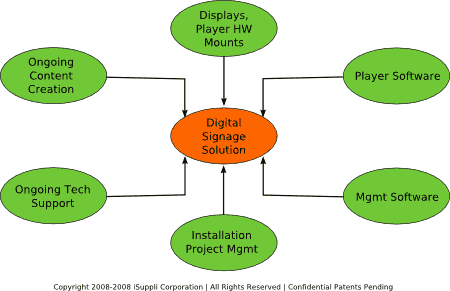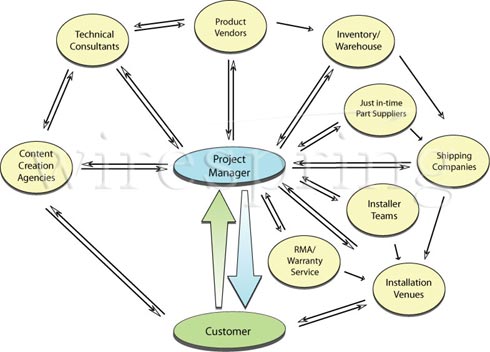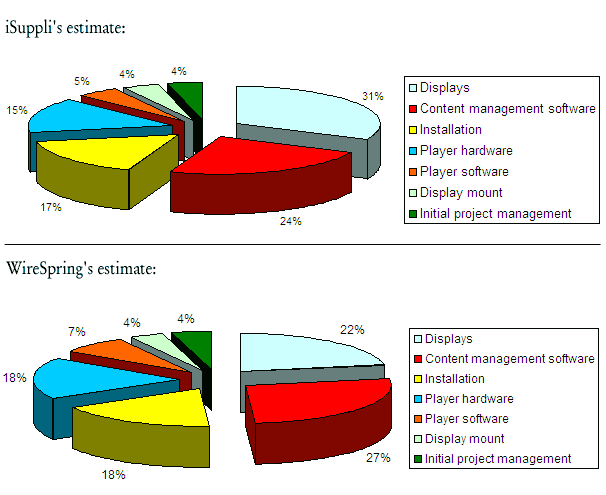What the heck is a "digital signage ecosystem"?
We've written a number of articles about the essential role a project manager or integrator plays in any digital signage installation. Whether it's an internal person or team responsible for overseeing the implementation of the project, or an outside firm hired explicitly for the cause, the project manager may have to communicate with (and foster communications between) any number of vendors, partners and customer endpoints. In iSuppli's mind, such a scenario looks like this:

As it just so happens, I recently wrote an article about project management for Sign Business Magazine, and did up my own chart for the occasion. Here's how mine looks:

Of course, the two images are capturing different things -- iSuppli's focuses on the parts that go into a digital signage solution, whereas ours focuses on the people that make it work. Where they list a separate bubble for suppliers of different software and hardware components, we just list "product vendors," and then show the relationships that take those products off the shelves and put them to use. I think this is particularly useful when trying to illustrate how complicated a project can get, even in the early stages. My point with all this? Too many companies still think "parts" rather than "people" when approaching digital signage. This can lead them down an expensive and time-consuming path that ends with a marginally successful installation (if the network gets installed at all). The parts are certainly important -- after all, I'm a parts guy myself -- but it takes substantial know-how to put them together and keep them not just working, but working to their fullest potential.
Revisiting the cost issue
The other part of the article that grabbed my attention is where they talk about the cost of deploying a digital signage network. Since we do a similar article in this blog about once a year, I was eager to see how our latest cost estimate based on actual digital signage projects stacks up against iSuppli's mountain of research. Here are the two charts side-by-side:

Wow, it's a good thing that the number of categories and the names for each one (which we've been using for about four years now, mind you) are exactly the same. Otherwise, a comparison might have been a bit more difficult. The first thing you may notice is that iSuppli's chart is for initial costs only, so the pricing for "content management software" must assume a one-time license fee, and not a pay-as-you-go model like we use. That's fine, because our costs (which are based on Software-as-a-Service, but not necessarily our exact pricing for FireCast) assume three years of service and technical support, so that may be a wash. Also notice that iSuppli omits technical support from their pricing scheme, despite the fact that they list it in their ecosystem diagram. This suggests that they're either bundling some portion of it into the costs for the various software components, or they've left it out because it's not part of the initial project cost. To wit, Khatri notes that:
There are two main components for the ongoing cost -- content creation and technical support. The content cost is the big unknown and probably the biggest factor in (sic) the digital signage network does not work.... Depending on the scale of deployment, around 80 percent of the ongoing cost could be attributed to content creation and the rest (or 20 percent) to ongoing technical support for content and network management.Without any ongoing cost estimates to start from, I can't speculate what iSuppli thinks it might cost to maintain a network over time. But I can tell you that based on our estimates, perhaps as much as 60% of the content management software fee goes towards technical support or upgrades in some form or fashion.
In any event, our numbers seem close enough to iSuppli's (in percentage terms, at least) to suggest that they're still a good ballpark estimate for those planning to deploy a digital signage network. However, if you're just getting started, I definitely recommend you take a long, hard look at the organizational chart above and try to budget your time and money accordingly. It may seem easy to figure out how much the different parts of your project will cost. But when it comes time to finally turn on your network, you'll find that it's just as important to have the right people on your team.
Have you deployed a digital signage network, or do you have one in the works? What changes would you make to the charts above? Leave a comment and let me know.

 Subscribe to the Digital Signage Insider RSS feed
Subscribe to the Digital Signage Insider RSS feed
Comments
RSS feed for comments to this post